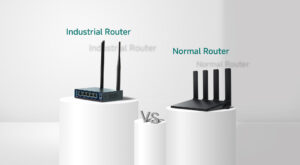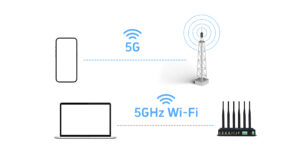In today’s fast-paced industrial environments, network reliability is critical. Whether in smart factories, remote oil fields, or automated warehouses, losing connectivity can mean costly downtime. This is where cellular access points come in—a game-changing solution that combines traditional Wi-Fi with 5G/4G LTE cellular backup to ensure uninterrupted operations.
Qu'est-ce qu'un point d'accès cellulaire ?
A cellular WiFi access point (also called a cellular wireless access point) is a networking device that provides both Wi-Fi and cellular connectivity. Unlike standard points d'accès that rely solely on wired broadband, these devices integrate 5G/4G LTE modules, allowing them to switch seamlessly between wired and cellular networks when the primary connection fails.
Les principales caractéristiques des points d’accès cellulaires modernes comprennent :
- Sauvegarde sur double réseau – Automatic failover between wired and cellular broadband.
- Connectivité 5G haut débit – Utilizing 5G Sub-6GHz for IoT and eMBB (Enhanced Mobile Broadband) applications.
- Rétrocompatibilité – Support for 4G LTE and 3G when 5G is unavailable.
- Prise en charge du Wi-Fi 6 – Faster speeds, lower latency, and better performance in high-density environments.
Pourquoi les applications industrielles ont besoin de points d'accès cellulaires
Industrial settings demand uninterrupted, high-bandwidth connectivity. Traditional points d'accès Wi-Fi can fail due to fiber cuts, power outages, or interference. A 5G cellular access point solves this by providing:
1. Fiabilité inégalée grâce à la sauvegarde sur double réseau
- If the primary wired connection fails, the device automatically switches to 5G/4G cellular without disruption.
- Critical for SCADA systems, remote monitoring, and automated machinery.
2. 5G haut débit et faible latence pour l'IoT industriel
- 5G NR (NSA & SA) support ensures ultra-fast data transfer for real-time analytics, AGVs (Automated Guided Vehicles), and AI-driven automation.
- The Qualcomm X62-based 5G module (used in leading models) delivers peak speeds and superior stability.
3. Connectivité à l'épreuve du temps
- 3GPP Release 16 compatibility ensures long-term support for evolving 5G standards.
- Wi-Fi 6 (802.11ax) enhances performance in crowded wireless environments.
Cas d'utilisation des points d'accès cellulaires dans les réseaux industriels
- Fabrication intelligente – Ensures real-time machine communication even if the main network goes down.
- Sites éloignés de pétrole et de gaz – Provides last-mile connectivity where wired infrastructure is unavailable.
- Transport et logistique – Keeps warehouse robots and tracking systems online 24/7.
- Services publics et réseaux intelligents – Enables failproof monitoring of substations and pipelines.
Choisir le bon point d'accès cellulaire
When selecting a cellular access point for industrial applications, consider:
- 5G contre 4G LTE – 5G offers higher speeds, but 4G LTE may suffice for some use cases.
- Prise en charge du Wi-Fi 6 – Essential for high-density IoT deployments.
- Conception robuste – Look for IP67-rated, wide-temperature-range models for harsh environments.
- Basculement transparent – Ensure automatic switching between wired and cellular networks.
Leading solutions in this space (including some cutting-edge models like Come-Star CIAP716N-6A25 incorporate 5G M.2 modules, dual-network backup, and industrial-grade durability, making them ideal for mission-critical operations.
Réflexions finales
As industries embrace Industry 4.0, the demand for cellular internet access points will only grow. By combining Wi-Fi 6 and 5G cellular backup, these devices provide the redundancy, speed, and reliability that modern industrial networks require.
Whether you’re managing a smart factory, a remote mining site, or a large-scale logistics hub, a cellular wireless access point ensures that your operations stay connected—no matter what.


